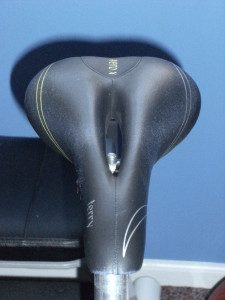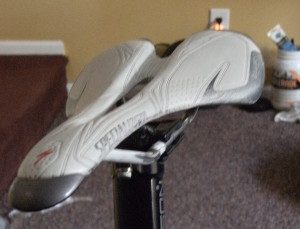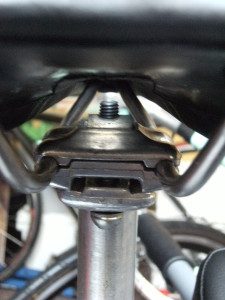By : edurkee
April and May are the months to start thinking about Spring biking! It’s never too early to dream about the snow melting and the roads clearing and the bike trails calling out “Ride Me!”. In preparation, I will be writing a series of articles on bike parts and how to out-fit your bicycle so that it is comfortable and fun to ride by the time you are all ready to clean up your spring/summer bike and get out in the spring weather.
One of the most important components to your bicycle is your saddle. The saddle or seat, both terms are acceptable, is your first and major point of contact with your machine. Therefore, it is important to get it right or you will be in constant discomfort. You never know how much, even until you hop on a different saddle and realize that the one you have been bearing with is actually causing chafing, sore pressure points, and keeping you from really loving your ride.
A quick anecdote from the Dr., since the Dr. loves anecdotes. My first 2 bicycles came with pretty standard used bicycle components. The saddle on the first was a white, faux-leather cruiser seat complete with the sitz bone bruising spring loaded action so common among old saddles. I bore with that one and eventually came to ignore all together that my butt bones felt like someone had been jack-hammering them all day long. A year later, when I got the love of my life, a real old-school Fuji roadbike, it came with a vastly upgraded saddle from the 80’s, smooth black acrylic cover over foam and plastic. It even had a groove to cushion the tail-bone. High tech as it was (sarcasm), after several weeks of intense commuting in the hot hot heat of summer sent me to the doctor with an odd condition similar, or so I imagined, to a non-bike related illness. The doctor snickered at my concerns and recommended diaper cream. Later that summer, on impulse, I was wandering in a shop and happened to come upon a women’s saddle for $30 in the sale corner and after 2 seconds of debate, snatched up and slapped it on my bicycle, riding away with whoops of joy and plenty of air flowing through the cut-out, making me realize what had been missing from my ride for so long- comfort!
I still have that saddle and it resides on my favorite commuting bike, perfectly molded to my bum and continues to make me very happy. What’s so special about this seat that sets it aside from those of the past?
A lucky find is easier to come upon when you know the basics of saddle comfort and function. There are 3 main factors to saddle options. They are width, cushion, shape, and perhaps we can add aesthetics (you would not want to put a cruiser saddle, for example, on a mountain bike or a racing bike for all of these reasons). Saddles are made of a variety of materials from synthetics to leather. The main construction of a saddle is it’s frame, which will be either a plastic or carbon then covered by some layers of foam or in the case of hard saddles, very little to none. Leather saddles, such as a Brooks, will be a hard leather over a metal frame, where the cushioning comes from the leather’s flexibility and molding.
It is important to think through what kind of riding you want to do on your saddle. For short distances a casual saddle should be fine. A cruiser saddle will be highly cushioned, flat, wide, and generally have springs to absorb impact. I would never recommend a cruiser saddle on anything but a cruiser. For people who need a more cushioned, wide saddle I would generally tell them to stick with the very casual riding or consider looking into a recumbent for extra back support.
Mountain bikes generally have flat, more padded saddles that are fairly narrow. The padding will make a huge difference when you are riding bumpy terrain and perhaps have contact with your saddle that you aren’t prepared for. For riding in the city on a mountain bike, you may want to consider less padding as you are less likely to be standing and riding.
Road bikes, cyclo-cross bikes and track bikes are the most useful for commuting and riding long distances. The best saddles for these riding styles are generally narrow, fairly hard, and the most varied in terms of options. These saddles are most likely the type that are so varied that it is hard to even make a decision about what will be right for you. Why would you want a hard and narrow saddle? That sounds really uncomfortable. Contrary to the common deduction that more padding is better for comfort, saddles with less surface area and therefore opportunities for chafing and pressure points are better. You will also want to look for rounded edges vs. flatter saddles, length, cut-out vs. solid, and stiffness. Many people prefer Brooks or leather saddles over synthetic saddles because they wear in and mold to your butt. Synthetic saddles, however, require less surface care and are better to care for in bad weather. They are also easier to find in cut-out styles (which I would recommend any person with a vulva try, it will relieve the major problems of older, solid saddles).
Here are several picture of the saddles in my coterie, you will notice that they are all cut-outs for cradling the softer parts and rather narrow because of my hip positioning. They are both labeled as “women” saddles, which are generally wider at the back and a few centimeters shorter than saddles labeled as “men’s.”
 My road bike has a saddle with a little more cushioning and a curve that keeps one kind of floating rather than sinking back into the saddle. I did start out with a Brooks Imperial, but I found it too wide in the back and had resulting hip pain from the saddle working as a fulcrum against my femur/hip bones when riding. To avoid this, make sure your saddle allows for hip clearance while you are riding. Shops should allow you to try a saddle before you buy it, so be prepared to take off your current saddle and put a new one on to ride it around the block (I will also cover different attachment types below).
My road bike has a saddle with a little more cushioning and a curve that keeps one kind of floating rather than sinking back into the saddle. I did start out with a Brooks Imperial, but I found it too wide in the back and had resulting hip pain from the saddle working as a fulcrum against my femur/hip bones when riding. To avoid this, make sure your saddle allows for hip clearance while you are riding. Shops should allow you to try a saddle before you buy it, so be prepared to take off your current saddle and put a new one on to ride it around the block (I will also cover different attachment types below).

My commuter saddle is very hard and is better for shorter distances unless I am wearing a chamois (padded shorts). I like this one very much, though, because the cut-out is larger and the seat has a dip in it that cradles the bum. The front is a little narrower and I have less of a problem with saddle-sores when I choose not to wear a chamois.

This is my partner’s racing saddle. It is very minimalist and used only with a chamois, but has minimal points of contact which means less chafing and less pressure points. The main important factor of this saddle is it’s over-all fit with the bicycle. Seat height and forward/backward positioning is very important and will ensure your knees do not ache as much (or at all!).
One thing further- Be prepared to take your saddle on and off so you can try different types. There are 2 main modern attachment types. You will need your Allen-Wrenches (octagonal-head screw driver). Install seats level first and try them before any angling. You need to make sure the bolt is lightly greased before the final installation so it will not rust into the attachment. Tighten seat bolts as much as you can, if it’s loose your seat will wiggle and wobble and change it’s position.


Double Bolt: Allows for precise angeling
